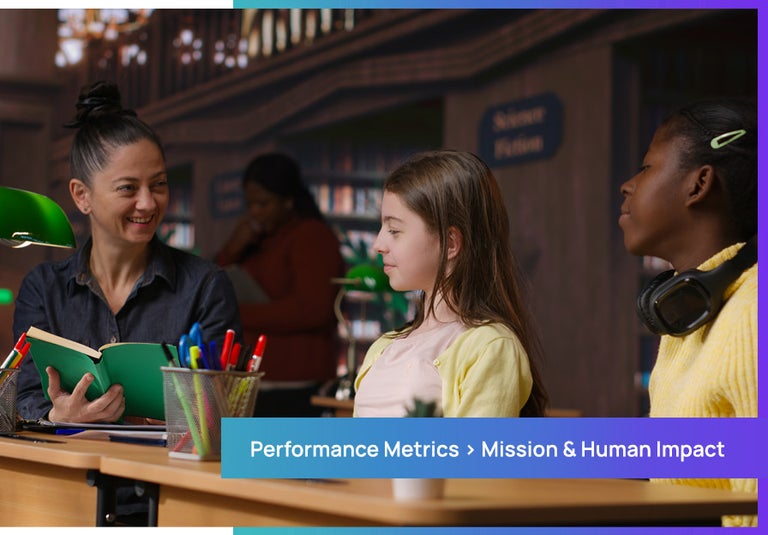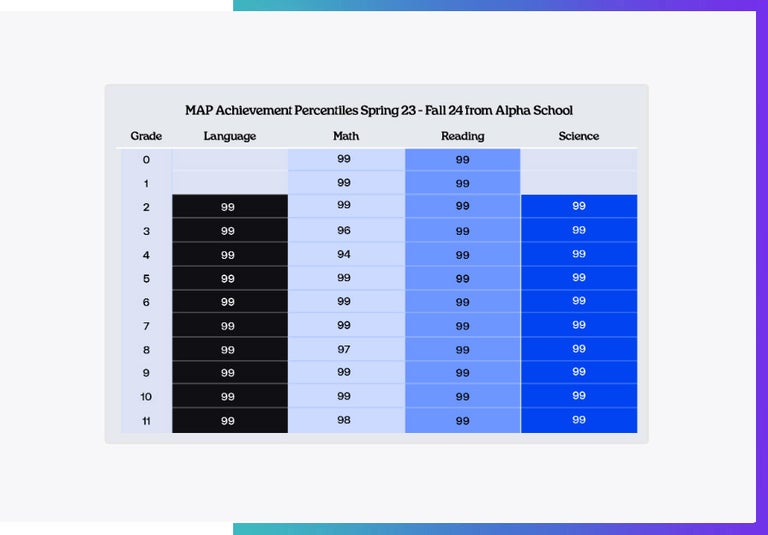Contents
- The Principle Intelligence of Leadership
- Integration Intelligence: The Operating System of Today
- Shift #1: Curriculum Control to Learning Ecosystem Design
- Shift #2: Instructional Oversight to AI Integration Strategy
- Shift #3: Performance Metrics to Mission Human Impact
- The Final Shift: Building What’s Next
What’s left to lead when AI can teach, test, and track better than we can? Education is being rebuilt from the inside out. As artificial intelligence takes over content delivery and personalization, the role of the education leader is undergoing its own transformation. Here’s why traditional oversight no longer works - and the three bold mindset shifts you must make to crush it in this new AI-first era.
How do you lead when AI is dismantling education as we know it?
Poke around online and you’ll see – the future of education is still AI.
I say still because education has been trundling towards this inevitable destination since modern tech sprang to life decades ago.
We’ve been using artificial intelligence in educational technology for 50+ years.
- Automated assessments and feedback started in the 60s with Project Essay Grade (PEG)
- Learning gamification was tapped by Carnegie Learning in the 70’s and 80’s (Math Blaster!)
- The 90’s Intelligent Tutoring Systems (ITS) for learning personalization (AutoTutor)
Startling then, that since that global spike in AI use – 80% of school leaders STILL prioritize curriculum compliance over adaptive, AI-enabled systems.
It’s a bit like watching a group project where no one wants to go first… for 40 years.
But education needs transformative leaders now more than ever before.
It’s easy to strap on the cement boots of systemic bureaucracy and sink to the bottom of a dam that stopped flowing years ago. But if you’re an education leader who wants to be part of this rapid, messy and glorious flood of change – grab your life jacket.
So, what does leadership look like in the AI era – where curriculum is commoditized, everything is personalized, and the mangy model of top-down academic control has been dismantled?

The role of an education leader isn’t to manage curriculum or enforce outdated standards anymore. It’s to freshly design AI-powered environments where learning happens in progressive and exciting ways.
In this article, I reveal what it truly means to lead in an AI-first education system - and why the old model of oversight is collapsing. You’ll learn the three bold mindset shifts every education leader must make to stay relevant, impactful, and ahead of the curve.
Every era runs on a dominant operating system.
Time to update yours.
The Principle Intelligence of Leadership
What made leadership work in education yesterday, doesn’t work today.
Surprise!
Every era has a core skill, a single driving intelligence that defines what it means to be effective. I call this the principle intelligence of leadership.
It’s the deep, often ghostly capacity that fuels how leaders make decisions, shape systems and otherwise move people forward.
In traditional education systems the core intelligence was ‘co-ordination’ styled leadership. It was your job to align people to plans, policies and procedures.
You had to enforce curriculum standards, and standardize student outcomes. Success as a leader was rooted in co-ordination – with the most effective leaders succeeding by being great managers of complexity and consistency.
Well, AI has made that redundant.

- Ethan Mollick recently shared a World Bank Study that showed GPT-4 tutors with teacher guidance have 2X the effect of some the most effective interventions in education. And they’re outstandingly low-cost solutions.
- That same study showed students who used AI agents (tutors) like Khanmigo showed 2-3X FASTER concept mastery, with no teacher intervention.
- Plus, McKinsey states up to 40% of teacher hours are spent on activities that can be fully automated now, with existing tech.
For education leaders in the K-12 space, who have always been trained on managing teachers who build the curriculum – this is a massive, massive shift.
Integration Intelligence: The Operating System of Today
In Principal Leadership (wordplay intended) – we acknowledge that content is infinite and change is relentless. You can’t be an instructional expert or a top-down authority.
A new kind of leadership DNA is needed.
The kind where automation handles the predictable, endless flow of content and knowledge – and you do more important things.
Modern educational leadership demands integration intelligence above all – the ability to delicately and courageously weave together people, purpose and intelligent tools into one cohesive, adaptive learning ecosystem.
This is intelligence that prioritizes designing systems where humans and machines can learn, create and grow TOGETHER.
The fusion of emotional intelligence, systems thinking and AI fluency. Leaders with Principal Intelligence architect the change in this new era.
Your job is literally to trust technology, know when to challenge it - and when to step back so that students can lead. To build environments where curiosity scales, agency blooms and real-world impact is even MORE important than test scores.
In short: Principal Intelligence is how human leadership remains essential in a world where curriculum, assessment and instruction aren’t human led anymore.

Your Leadership Superpowers:
Principal Intelligence = Integration Leadership
- You can see around corners and anticipate how AI will change learning and proactively design for it.
- You have systemic empathy and understand how people, tools, and environments interact (leading with both data and compassion).
- Adaptive design thinking is your default, and you can rapidly iterate systems that prioritize human growth while leveraging AI’s authentic strengths.
- Cultural stewardship is key, and you work to build trust, curiosity, and alignment when AND where algorithms can’t (and never will).
- Credible experimentation is your jam, and you make bold, evidence-based moves that challenge trad education while protecting your integration mission.
Cool beans, right? But easier said than done.
This is a full system upgrade. It demands that you break from your old mindset, and how you’ve always gone about leading in the past. If you want to lead the way in our AI-first future, you need to reboot, much like the system is doing.
That means rewiring how you think about curriculum, instruction and outcomes. It starts here, right now – with three radical mindset shifts in how you lead.
Nail them and you’ll stop being a legacy leader, and shift into future-ready architect mode.
Shift #1: Curriculum Control to Learning Ecosystem Design
AKA: Stop managing content and start engineering curiosity.
You were once a curriculum cop, hyper-focused on managing what got taught, when and how. Makes sense in a content-thin environment, but now we’re content-rich.
AI has made educational content infinite. In an AI-first school your job isn’t to control what gets taught - it’s to design the conditions where REAL learning happens.

A 2024 study from Harvard University found that students using an AI-powered tutor learned more than twice as much as those in an active-learning classroom. And in less time! AI systems outperform expert teachers, delivering content faster, more personally, and with higher student engagement.
Your new leadership mandate:
- Design the HOW, not the WHAT
AI handles the knowledge. You shape the timing, context, and experience of learning. Think like a systems architect, not a curriculum gatekeeper. - Build for autonomy, not control RIP standardized pacing. Your job is to create environments that encourage self-direction, feedback, and brave exploration.
- Coach people, not content
Teachers aren’t content machines anymore. Lead them to become mentors, co-pilots, and facilitators of school culture and student growth.
AI delivers on curriculum KPIs, so you should deliver on creating an environment dialed into learning, connection and collaboration.
Shift #2: Instructional Oversight to AI Integration Strategy
AKA: Lead like a CTO, not a hall monitor.
Traditional leadership once meant monitoring instruction, tracking teachers and enforcing standardized compliance. But AI has killed standardization.
Now, you must integrate AI tools strategically – to guide your team to co-pilot with AI, automate their routines, and make sure your tech team is aligned with your goals.

A 2025 peer-reviewed analysis of school management practices showed that AI automates about 40% of routine teaching and admin tasks, especially around progress-tracking and formative feedback. This frees your teachers to deepen human interaction, and helps you deploy new AI tech ethically and effectively.
Your teachers are free…rejoice! Refocus on who teaches what, and how they are going to work with AI to make things exceptional.
Your new leadership mandate:
- Be the leader of learning Just like a technology leader designs systems that balance human strengths and machine efficiency, you must choose great AI tools, define prompt workflows and guardrails and make sure AI compliments (rather than detracts) from class.
- Choose who does what Great leaders ask questions like – “Which tasks benefit from human empathy and creativity? Which ones are better automated?” AI can handle low-value work - diagnostic quizzes, data entry, initial feedback - while educators focus on mentoring, project-based learning, and conceptual coaching.
- Coach staff to co-pilot with AI Shift pedagogy from checklists and compliance to collaboration. Replace walkthroughs and teacher tracking with team-based integration sessions, where staff experiment with AI use-cases, refine prompts, and share what’s working.
AI isn’t a tool to manage, it’s a partner you need to integrate. These integrated human-AI learning systems will keep changing, so make this a system.
Shift #3: Performance Metrics to Mission & Human Impact
AKA: Measure what AI can’t (purpose, grit, growth)
Pre-AI you were focused on chasing test scores and raising academic KPIs with the aim of either getting everyone through the load, or making your school look great.
AI optimizes these basics for you now, so your value needs to shift to measuring what matters most – student engagement, creativity, resilience, purpose, love for learning – and those critical life skills that help kids get ahead.

Sure, AI can optimize academic outcomes - but its real promise lies in giving students the time and freedom to build life‑defining skills that matter.
At Alpha, powered by 2 Hour Learning, students complete all core academics in just two hours per day, allowing afternoons to be spent on high-impact projects: pitching to VCs, building robots, launching micro-businesses, learning to swim, or running leadership workshops.

The impact is profound: 2x faster academic mastery, and students - some entering in the 31st percentile - rising to the 84th percentile in just one year!
Your new leadership mandate:
- Champion experiential, project-based learning When AI delivers core instruction, you get time and space to create real-world challenges - like entrepreneurial pitches or robotics builds - that cultivate grit, creativity, and leadership.
- Measure what matters Are your kids ready for the drastic pace of change in the real world? You can help them by measuring what matters – personal achievements won, prototypes built, or leadership roles taken.
- Empower human guides With AI handling academic delivery, your staff become mentors and project facilitators - coaching students through challenges that machines can’t replicate. Suddenly, kids get 1:1 attention again.
AI personalizes learning, so you need to personalize motivation. Your job is to use the gift of time it creates to fuel real-world learning - this is where lifelong impact is born and real student success happens.
The Final Shift: Building What’s Next
The AI era doesn’t eliminate the need for leadership - it reinvents it.
And that reinvention starts with you.
If you’ve read this far, you already know: the old model of leadership won’t carry us forward. Coordinating curriculum and enforcing instructional compliance made sense in an era of scarcity.

But these days - content is infinite. AI is accelerating. And education needs leaders who don’t just manage - they build new things. Better things.
This is the new Principal Intelligence: the ability to integrate people, purpose, and intelligent tools into systems where learning actually works - for real kids, in real time, with real-world outcomes.
That means embracing three powerful mindset shifts:
- From managing curriculum > to engineering curiosity
- From overseeing instruction > to integrating AI with intention
- From chasing performance metrics > to championing purpose and growth
The future of education won’t be led by leaders who cling to the past, like cats on a woolen curtain.
It will be shaped by those brave enough to rewrite the rules, rebuild the systems, and reimagine what leadership truly looks like today. Right now.
And if you're ready to be one of them - to stop managing and start architecting - to lead the AI-first future of education, we want you.
Apply now for an education leadership role
We’re hiring the next generation of learning architects.
Join us. The system is updating. Our education clients need leaders ready for a reboot.








